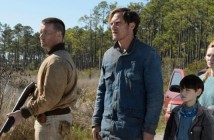Editor’s Notes: The following review is part of our coverage of the 2015 Vancouver International Film Festival. For more information on the festival visit viff.org and follow VIFF on Twitter at @viffest.
Though Tom Hiddleston is superb in the role of Hank Williams, Marc Abraham’s fictional biopic I Saw the Light follows a sluggish script replete with banal romantic ventures and non-intimate portraiture. It does a rather poor job at conveying Hank Williams’ complex personality, instead dramatizing his vices for shock value. Instead of giving the man the respect of focusing on his music career, Abraham focuses on his troubled life, exploiting it for cinematic purposes. He is painted neither as a genius nor even as a reputable musician, but berated incessantly for his womanizing ways. As the film continues, the monotonous rhythm and script continually presents banal information, never offering anything of value. By the end of the film, the only true and personal thing one learns is that Hank Williams really liked Ketchup.
The film too fails in its stylistic gestures. Abraham consistently crosses the axis of action, a major no-no in conventional Hollywood filmmaking for reason. Crossing the axis of action causes disorientation, and only great directors truly use this trick well. Abraham is frankly not one of these directors. This stylistic maneuver feels like a gimmick more than a directorial nuance. It does however bring respite from the monotony of the dialogue. I Saw the Light is exceedingly wordy and theatrical, with much dialogue and little if any visual storytelling. Not only that, the characters keep talking about the same things over and over again, beating the dead horse to unrecognizability.
The only real appeal of the film is the music scenes, wherein Hank Williams is shown either in concert or in the studio. The music is rich, and the film latches onto this talent. The film’s strongest scene by far is its opening, wherein Tom Hiddleston as Hank Williams sits alone on a brightly lit stage playing his music. The scene recalls the opening of the recent film Inside Llewyn Davis by the Coen Brothers, and I’d wager that Abraham drew influence from it. The rest of the music scenes are rather conventionally shot, which, in this case, is a positive. The film’s somewhat unbearable style fortunately does not ruin the music.
By the end of I Saw the Light, which only depicts Hank Williams from age 23 to 29, little is shown besides the surface issues of his infidelity and alcoholism. There is one scene wherein Hank speaks about a darkness which he brings to the stage so that people can experience it through his music—and therefore not have to take it home with them. It’s a singular moment of intimacy which the film doesn’t at all bring to context. But not all is bad; one could watch Tom Hiddleston gleefully press a garage door opener all day.
Though Tom Hiddleston is superb in the role of Hank Williams, Marc Abraham’s fictional biopic I Saw the Light follows a sluggish script replete with banal romantic ventures and non-intimate portraiture. It does a rather poor job at conveying Hank Williams’ complex personality, instead dramatizing his vices for shock value.




